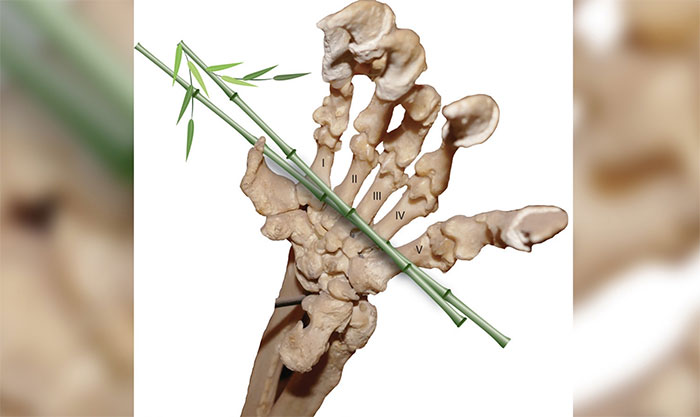The fossils belong to an ancient, now-extinct relative of the panda known as Ailurarcto, discovered in the city of Zhaotong, Yunnan Province, China.
From these fossils, scientists have decoded why pandas are “strict herbivores” and how their ancestors had a different “pseudo-thumb” than those present today.

The fossilized thumb does not have the inner hook like modern pandas.
The fossils found include a pseudo-thumb that is longer than the thumb of modern pandas. Moreover, the fossilized thumb also lacks the inner hook that modern pandas have. This evolutionary change occurred because it had to “bear a significant load of body weight” – scientists explain.
Additionally, the fossils also feature a greatly enlarged wrist bone known as the radial sesamoid. Sesamoid bones are structures found within tendons, commonly seen near joints in the hands and feet.
The discovery of this fossil has helped researchers solve the mystery of how this panda species developed its “pseudo-thumb” and became the only “strict herbivore” in the bear family.
These fossils are also the oldest known evidence of the pseudo-thumb of modern giant pandas. This pseudo-thumb allows pandas to easily grip and break bamboo stalks.
“Giant pandas are a rare case of a large carnivorous species with a short digestive tract that has evolved into a strictly herbivorous animal” – according to Wang Xiaoming, the curator of vertebrate paleontology at the Natural History Museum in Los Angeles, USA.
“The pseudo-thumb in Ailurarctos first illustrates the timeline and steps in the evolutionary process from a carnivorous animal to one that primarily consumes bamboo,” Wang Xiaoming added.
Researchers indicate that for nearly a century, the pseudo-thumb of pandas has functioned similarly to the human thumb. However, the lack of fossil evidence has left unanswered questions about how and when pandas evolved to develop the pseudo-thumb. It is also noted that the pseudo-thumb is not found in any other bear species.
“Although the pseudo-thumb of giant pandas may not appear very impressive or dexterous, even a small bump protruding at the wrist can be quite helpful in preventing bamboo from slipping out of their curved fingers,” Wang further explained.
Pandas transitioned from a protein-rich, omnivorous diet of their ancestors millions of years ago to a bamboo diet that is low in nutrients. Pandas spend up to 15 hours a day eating, and an adult panda can consume up to 45 kg of bamboo each day.


















































